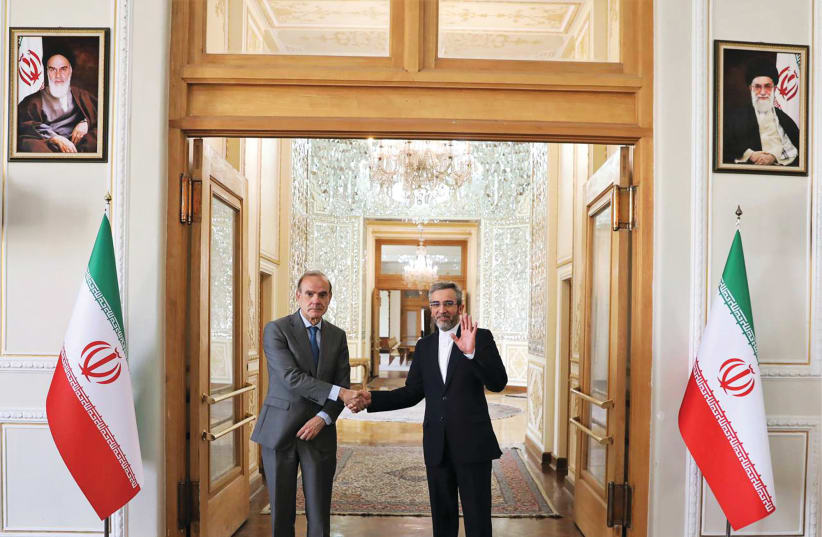After months of hibernation, Iran nuclear talks woke up again last month, when the European Union presented what it said was the final draft of the deal on July 21. Since then, Iran submitted its response, continuing to make demands on the sanctions relief and guarantees front, which American diplomats and Israeli sources say Washington did not accept.
However, the sides agree on most of the overall deal based on the July 21 draft.
The EU text describes the implementation in four steps.
The four steps
On “day zero,” the day on which the deal would be signed, the Joint Commission founded when the Joint Comprehensive Plan of Action, as the Iran nuclear deal is known, was formed in 2015, would convene without the US, which would only be able to join the commission 165 days later.
By that time, Iran and the West are supposed to reach an additional deal to free Western prisoners in exchange for freeing Iranian funds.
That day, US President Joe Biden would rescind three executive orders pertaining to Iran, as well as secondary sanctions on 17 banks, which would free over $7 billion belonging to Iran from South Korean banks.
Iran would stop enriching uranium to 60% and reduce enrichment to 20%, and allow for the International Atomic Energy Agency to begin the resumption of monitoring Iranian nuclear sites.
Within five days, the deal will likely reach the US Congress, under the terms of the Iran Nuclear Agreement Review Act (INARA). That law requires any agreement lifting sanctions on Iran to be reviewed by the House and Senate, and the White House would not be able to lift sanctions that were not an executive order for 30 days.
If Congress rejects the deal, Biden can veto it, except in the unlikely scenario that a veto-proof majority of two-thirds votes against it. There is, however, still a chance of a majority opposing a deal, amid growing concerns in Washington that Russia will use Iran as a conduit to avoid sanctions.
There are some who argue that because this is a return to the JCPOA and not a new agreement, INARA does not apply. However, US Iran Envoy Rob Malley said in the Senate in May that the agreement will be brought to Congress in the framework of INARA.
The next step in implementing the deal, “confirmation day” would come 60 days after “day zero.” The UN Security Council and IAEA would be notified of a return to the agreement.
The US would give a one-time sanctions exemption for Iran to sell 50 million barrels of oil and would permit business negotiations in the areas of energy and aviation.
Iran would stop enriching uranium to over 5% purity and would start a preparation period to transfer information to IAEA and allow the agency to fully resume monitoring.
Two months later, day 120, would be “reimplementation day.” Iran and the US would have to publicly declare their intention to continue to return to the deal at least seven days prior to that date.
By reimplementation day, Iran would have to fulfill its commitments to the IAEA regarding its ongoing investigation into enriched uranium found at undeclared nuclear sites in Iran. That means Iran would give the IAEA a credible response as to the source of that uranium, and the IAEA would, in turn, close the probes.
Iran would also complete all the steps required by the deal – scaling back uranium enrichment to 3.67%, reducing its stockpile, sealing and transferring centrifuges, etc. – and allow the IAEA to fully resume monitoring.
The US would remove all secondary sanctions on Iran and agreed-upon terrorist designations – this does not include the Islamic Revolutionary Guard Corps – and explain to businesses what the lifting of sanctions means.
“Completion day” would come on day 165, on which all nuclear restrictions and sanctions relief would go into effect. The US would lift the conventional arms embargo on Iran and allow further trade between the countries, and Iran would remove the remaining enrichment infrastructure.
In the coming years, the JCPOA’s original “sunset clauses” would go into effect in accordance with UNSC Resolution 2231, without any extensions.
In 2024, limitations on advanced centrifuges research and development would begin to expire and in 2025 the “SnapBack sanctions” mechanism, which brings back all sanctions on Iran if it violates the deal, would expire.
In 2026, the restrictions on using centrifuges, including advanced ones, begin to expire, gradually until 2028.
In 2030, the Iran deal expires entirely, without limits on uranium enrichment, on stockpiling, heavy water reactors, or plutonium.
Israel and Iran's nuclear deal
With a deal seemingly inevitable, Jerusalem under Prime Minister Yair Lapid has decided to focus its efforts on several fronts.
First, to continue a dialogue with the US and to try to influence the stances of the other Western parties to the talks, with an emphasis on Britain and France.
In addition, Israel will try to convince the parties to reduce the economic benefits to Iran, by delaying or weakening sanctions relief.
Jerusalem plans to continue secret actions by intelligence agencies to thwart Iran’s nuclear program, as well as to follow closely to ensure Iran does not violate the agreement and block it from doing so, as well as from trying to destabilize the region. That will go together with building up the IDF’s capabilities to strike Iran.
Israel also plans to continue working on what the government has called its “regional security architecture” and work with Middle Eastern and other countries that border Iran.

